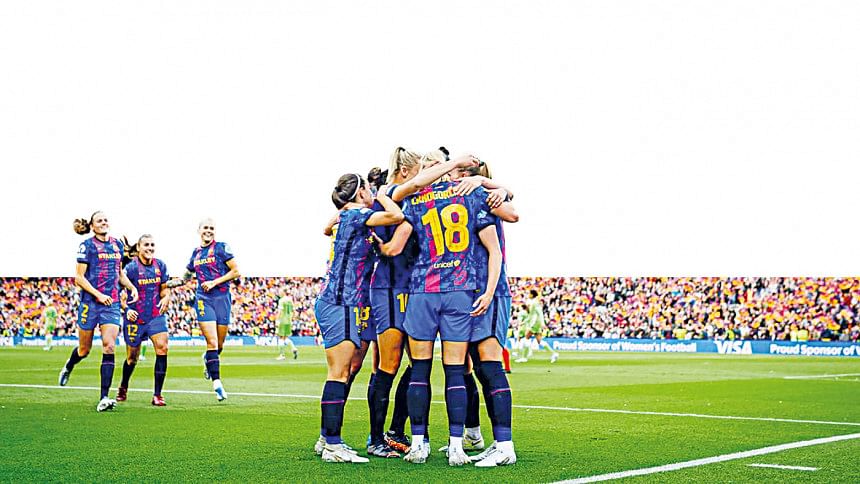In sync despite being 5 thousand miles apart

The beautiful game has been the most popular sport on the planet for over a century, but although the field has been dominated by men for most of its history, times have begun to change in the last few decades.
Women's football can trace its history back to the 1890s, when there were a number of women's clubs in England and one in north London was reported to have attracted 10,000 to a game at Crouch End.
Preston was the stronghold of women's football in those days after the famous Dick Kerr's Ladies were formed in 1894. Their match with St Helen's Ladies on Boxing Day 1920 featured the largest crowd for a women's game as 53,000 packed into Goodison Park and thousands remained locked outside.
However, following this success, the Football Association initiated a ban in 1921 in England that disallowed women's football games from taking place on the grounds used by its member clubs. That ban remained in effect until July 1971.
One can easily imagine a Classico where the likes of Karim Benzema, Vinicius Jr. and Luka Modric were lining up against Pedri, Sergio Busquets, and Gerard Pique, but none of those megastars were on the pitch that night.
While there were independent bodies that organised Women's World Cups, FIFA only held the inaugural FIFA Women's World Cup in China in 1991, which accelerated the women's game's popularity on a global scale. Since then, the sport has gained in popularity, with over 1.12 billion people worldwide tuning in to watch the 2019 FIFA Women's World Cup in France.
Nations like Germany, USA and Japan have dominated the international stage, but FC Barcelona Femeni have emerged as the crown jewel of club football in Europe and pulled off miracles.
On March 30 this year, Barcelona faced off against Real Madrid in front of a capacity Camp Nou. A record crowd of 91,553 turned up for that Champions League semifinal clash, which saw Real Madrid thrashed 5-2 at Camp Nou.
One can easily imagine a Classico where the likes of Karim Benzema, Vinicius Jr. and Luka Modric were lining up against Pedri, Sergio Busquets, and Gerard Pique, but none of those megastars were on the pitch that night. Instead, it was the Barcelona Femini taking on their counterparts.
Only matches at the unofficial 1971 Women's World Cup have ever attracted attendances for a women's sporting event in excess of that, with 110,000 people turning up for the final between Mexico and Denmark at the Azteca Stadium.
It was little over a decade ago that Barcelona Femeni were training on whatever pitch was available at ridiculous hours of the day. They have only been a professional side since 2015, but they now dominate Spain and have won the Women's Champions League in 2021 while breaking a 22-year record for attendance at a women's game.

How this team has become such a powerhouse in such a short amount of time?
The main factor was the injection of Barcelona's DNA, shaped by iconic figures like Johan Cruyff and Pep Guardiola and the philosophy of the three P's: possession, pressure and positioning. Even while their men's team has failed to entice spectators to the stadium on a regular basis, the Femeni team are beloved not only in Catalonia, but all over Spain.
A similar scenario has unfolded 5068 miles away in Bangladesh over the last few years, albeit on a smaller scale.
Packed stadiums during domestic football matches have not been witnessed in generations, but female footballers have started to get appreciable success after groundbreaking success in SAFF competitions, starting when the Under-15 side recorded huge wins such as the 6-0 hammering of Nepal and 3-0 triumphs over Bhutan and India in 2017.
The following year, a 14-0 victory over Pakistan in the SAFF U-15 Women's Championship and 10-0, 8-0 and 7-0 victories against Bahrain, Lebanon and UAE respectively in the AFC Under-16 Championship qualifiers inspired the entire nation.
Ever since, the number of spectators for the women's game has increased drastically. The most recent example would be the final of the 2021 SAFF U-19 Women's Championship, when Bangladesh beat India 1-0 in front of a capacity Bir Sherestha Shaheed Mostafa Kamal Stadium.
At the same venue this year, the Bangladesh senior women's team defeated Malaysia -- a team ranked 60 places higher than them -- by a massive 6-0 margin in front of yet another bustling crowd.
Despite the difference in level and quality, the growth of Barcelona Femeni and the Bangladesh women's football team have followed roughly the same timeline.
The only question that remains is what the future holds for these young footballers of Bangladesh. Will there be a sustainable approach that can form a solid foundation? And can the Bangladesh Football Federation implement a structure that ensures a long-lasting impact defined by the current run of success?

 For all latest news, follow The Daily Star's Google News channel.
For all latest news, follow The Daily Star's Google News channel. 








Comments